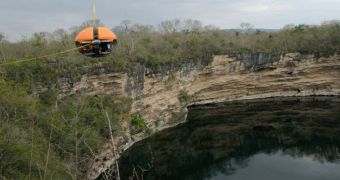When researchers sought out to investigate the world's second-deepest, water-filled sinkhole, they did not expect to find too much biodiversity. But their deep explorations robot managed to identify a surprisingly-large diversity and abundance of organisms, located even at depths where sunlight never penetrates. The fact that these microbial lifeforms manage to survive under these extreme conditions raises hope that similar life may exist on icy moons in our solar planets, or on exoplanets beyond.
In their research, scientists at NASA turned their attention to the Zacaton sinkhole in northeastern Mexico. A sinkhole is a landscape feature that is formed through karst processes, where carbonate rocks are dissolved. The result is oftentimes a hole, with a diameter and depth ranging from 1 to 300 meters. Sinkholes can be either empty or filled with water, and they can appear on both land and the bottom of the ocean. Due to its record-breaking traits, the Zacaton feature has become one of the most researched sinkholes there is.
The most recent investigation was conducted with a NASA robot called the Deep Phreatic Thermal Explorer (DEPTHX), which determined that the overall depth of the landscape feature is 339 meters (1,112 feet). But the robot is actually being tested for a future flight to Jupiter's moon Europe, which is covered in an icy crust. Experts know that, theoretically, life could exist below the ice there, but they want to known whether robotic explorers we send at the location are capable of discovering organic life forms. DEPTHX is apparently experienced at doing so. It managed to collect a large number of sealed plastic bags from the Zacaton sinkhole, which revealed entirely new organisms.
The machine also features a whooping 54 onboard sonar, which it uses to create high-resolution, three-dimensional maps of the internal structure of the sinkhole. The sample-collection equipment it also carries managed to collect small amount of water that led to the discovery of no less than100 new types of microbes and 6 new phyla of bacteria. “It's a vertical column that goes straight down into the Earth. We didn't know how deep before we went down,” explains Colorado School of Mines researcher John Spear, quoted by Space.
"Instead of photosynthesis, they're doing chemosynthesis, pulling carbon off of limestone," Spear said. "In the subsurface field we call it life in the slow lane – they have to take advantage of whatever's there,” Spear adds. The discovery “tells us that we still don't know the extent of diversity of life, which is an important thing in and of itself. When you can find three new phyla of bacteria without really trying that hard, how much out there are we missing?” he concludes in an interview for Astrobiology Magazine.

 14 DAY TRIAL //
14 DAY TRIAL //